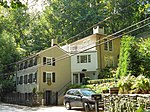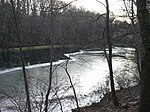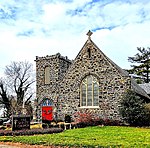Gladwyne Historic District
Historic districts in Montgomery County, PennsylvaniaHistoric districts on the National Register of Historic Places in PennsylvaniaMontgomery County, Pennsylvania Registered Historic Place stubsNRHP infobox with nocatNational Register of Historic Places in Montgomery County, Pennsylvania

Gladwyne Historic District is a national historic district located at Gladwyne in Lower Merion Township, Montgomery County, Pennsylvania. It encompasses 57 contributing buildings in the historic core of Gladwyne known as "Merion Square." It includes mainly mill or farm workers' dwelling. They are predominantly 2 1/2-story, two bay stuccoed stone structures dated to the early- to mid-19th century. Notable buildings include the Guard House Inn, "War Office" (1798), and Gladwyne Library.It was added to the National Register of Historic Places in 1980.
Excerpt from the Wikipedia article Gladwyne Historic District (License: CC BY-SA 3.0, Authors, Images).Gladwyne Historic District
Youngs Ford Road, Lower Merion Township
Geographical coordinates (GPS) Address Nearby Places Show on map
Geographical coordinates (GPS)
| Latitude | Longitude |
|---|---|
| N 40.036666666667 ° | E -75.281111111111 ° |
Address
gladwyne playground
Youngs Ford Road
19035 Lower Merion Township
Pennsylvania, United States
Open on Google Maps





